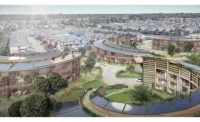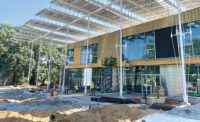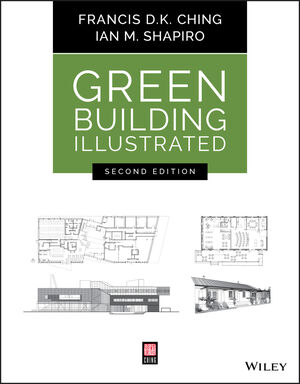The market for sustainable design and construction continues to grow. However, the well-ordered world of sustainable design and construction process through compliance with the U.S. Green Building Council’s Leadership in Energy and Environmental Design standards has become more complicated, with the growing acceptance of alternatives to LEED. The complexities and unfamiliarity of LEED Version 4 (v4) sustainability standards, and the growing client demand for more targeted sustainability options, such as healthy buildings or energy savings, have industry firms scrambling to keep up.
The market growth for green design and construction can be seen from the results of the ENR Top Green Buildings survey. As a group, the Top 100 Green Design Firms in 2017 generated $6.21 billion in design revenue from projects registered with and actively seeking certification from third-party ratings groups under objective sustainable-design standards, such as the USGBC’s LEED standards. For the group, this revenue is a 3.7% increase from the $5.99 billion in 2016.
Domestically, green design revenue rose 3.7%, to $5.01 billion, in 2017, from $4.83 billion in 2016. The Top 100 had $1.20 billion in revenue from green projects outside the U.S. in 2017, up 2.9% from 2016.
Among contractors, the market did well. As a group, the Top 100 in 2017 generated $62.11 billion in contracting revenue from projects actively seeking green certification. This revenue was up 8.5% for the group, from $57.25 billion in 2016. Domestically, the market was up 8.9%, to $55.06 billion, in 2017, while the international market for sustainable construction fell 1.5%, to $2.16 billion.
Related Links
ENR 2018 Top 100 Green Building Contractors
ENR 2018 Top 100 Green Buildings Design Firms
ENR 2018 Green Sourcebook PDF
(subscription required)
Not the Only Game in Town
For the past 10 years or so, LEED has been the gold standard for sustainable design and construction. However, over the past few years, alternative standards have grown in interest or have made their debuts. The Green Building Initiative’s Green Globes standard has been around for years. The Passive House standard out of Europe has gained a growing following in North America. The Living Building Challenge has set a high bar for sustainability that has sparked interest among some owners. And more targeted standards, such as the WELL Building standard and FitWel, governing healthy building design and construction, and Envision, covering sustainability in the infrastructure area, also are making an increasing impact.
When the USGBC released LEED v4 in 2013, with its materials content reporting and extensive documentation requirements, many industry firms and their clients were concerned about the feasibility and costs of certification, and they began exploring alternative standards. This move increased when USGBC stopped accepting new registrations under LEED 2009 in 2016.
As a result, sustainable building has been growing, but LEED is no longer the only game in town. “We haven’t seen any significant drop-off in LEED certifications with the advent of v4, though there is noticeably increased interest in other rating systems like WELL, Fitwel, Passive House and the Living Building Challenge,” says Ted Hyman, managing partner at ZGF. He says clients have become more sophisticated in their understanding of sustainability and have an open mind about which standard’s certification is the best fit.
“Dominance of LEED as a third-party certification tool over the market will continue to wane,” says Sujatha Das, sustainability & project manager at Haskell. The impact of sustainable design overall will continue to adapt to different markets and needs. He notes that some segments in the U.S. Dept. of Defense, such as the Air Force, no longer accept the LEED certification path and others, like the Navy, allow alternative certification paths.
Other customers also are now authorizing other certification programs. “Certain markets, particularly government projects, have opened up their certification options to Green Globes and other rating systems in addition to LEED,” says Eric Sheffer, principal and sustainability consultant for Smith Seckman Reid Inc.
As a result of a more demanding LEED system, Green Globes is becoming more popular. “Our experience is that clients tend to prefer Green Globes in fast-track projects, where schedules are tight, and the comparatively bureaucratic certification process of the USGBC’s LEED would impact project schedule,” says Chitani Ndisale, an architect at FLAD Architects. Further, “Green Globes verification and certification process comes at a lower cost than LEED,” he says.
PCL has noticed this trend in Canada, as well. “In some parts of Canada, we have seen a reduction in projects pursuing LEED certification since v4 came into effect. With the advent of new rating systems like WELL, Envision and Passive House, clients are adopting the rating system or design elements that best suit their industry or project,” says Scott Beckman, director of sustainability.

“An example of a decision [in LEED v4] that increased both stringency and complexity was the changing of the regional procurement radius from 500 miles to 100 miles. This was good in theory, but [often] there are simply no products that meet this new definition of ‘regional’ as written by LEED.”
–Steven Burke, Sustainability Manager at Consigli Construction Co.
Many in the industry embrace LEED v4, but question some of the changes in requirement. “An example of a decision that increased both stringency and complexity was the changing of the regional procurement radius from 500 miles to 100 miles. This was good in theory, but [often] there are simply no products that meet this new definition of ‘regional’ as written by LEED. This has ended up as a disincentive to pursuing regional products at all,” says Steven Burke, sustainability manager at Consigli Construction Co. He says this is unfortunate because previously, the regional contribution requirement frequently influenced product decisions, but this option may no longer be viable.
Another concern is the location and transportation and sustainable sites credits. “The objective is for owners to weigh these principles as they are selecting a site, but, unfortunately, the purchasing of property has too many other factors that outweigh these principles by far,” says Das of Haskell. “If the property meets these principles, it is easy to get the points; if it does not, then you can easily count them out of the project and you must strategize elsewhere.”
Another area of concern is the materials content reporting requirement. Currently the materials requirements for Environmental and Health Product Declarations have made it difficult to identify and manage the materials coming onto the site, as often the materials specified in the contract documents do not comply for many firms.
The ability to share information and know exactly what products are being placed into a project is critical. “Getting ahead of this during the design phase will be critical to the health of the sustainability market going forward,” says Chad Dorgan, vice president, quality and sustainability for McCarthy Building Cos.
Many firms are creating their own databases of material content. For example, Pepper Construction is creating a healthy materials library. “Now, we can start having those conversations with designers to help find healthier materials that meet the same design intent,” says Susan Heinking, vice president of high performance.
HKS has gone a step beyond. It created the Mindful Materials program to index healthy materials and has made it available to the public. “Mindful Materials is having a deep impact on how we address material selection and specifications,” says Rand Ekman, chief sustainability officer at HKS.
Many firms are taking advantage of this program and other types of tracking and documentation software to comply with LEED v4. “We are collaborating with groups like Mindful Materials, which tracks materials content, and utilizing platforms like Green Badger, a green documentation tracking software, to streamline our documentation processes and ease the strain on project teams,” says Jennifer Taranto, director of sustainability at Structure Tone. “Our solutions to the changes in LEED v4 are constantly evolving as other parts of our industry also get better at understanding and addressing the new requirements.”
Despite problems and complaints about LEED v4, many firms report that LEED registrations are up, despite the availability of alternatives. “An increase in project registrations occurred in the months before LEED v4 launched; however, our annual numbers are on pace to meet or exceed those of the LEED v2009 system,” says Allen Schaffer, principal and director of sustainable design at Moody Nolan. “We have not seen a reduction in LEED-certified work. However, the effect of LEED v4 is to be determined as those projects start up,” adds Daniel Piselli, director of sustainability and senior associate at FXCollaborative.
Why LEED v4 Is Necessary
Further, many leaders in the industry say the more stringent requirements of LEED v4 are necessary. “Project teams across the board were complacent with achieving high levels of certification with minimal effort in LEED v3,” says Gregory Plavcan, regional design resilience leader at Gensler. He says LEED v4 shifts the focus of designers to assess whole project life-cycle and human health impact and considers building materials after the life of the project.
“While v4 raised the bar as LEED is intended to do, the question remains: How fast can you lead the market before losing the market?” says Elizabeth Heider, chief sustainability officer of Skanska USA Inc. She notes that LEED v4 is more challenging in elective strategies such as material transparency, which are pushing manufacturers to catch up. She points out that when low volatile organic chemical paint was first introduced, the market had to adjust. “Now it’s hard to find paint that isn’t low VOC. This is a process, and we’re at the beginning of it with v4—the market has yet to adjust.”
LEED v4 has raised the bar along with the Living Building Challenge. The “standard” level systems are a level up from what they used to be and it’s because of pushing the limits with rating systems. “People can say what they want, but if the intended outcome is a more and more sustainable built environment, LEED v4 has been a success,” say Christopher Gorthy, project executive at DPR Construction.

“While v4 raised the bar as LEED is intended to do, the question remains: How fast can you lead the market before losing the market?”
–Elizabeth Heider, Chief Sustainability Officer, Skanska USA Inc.
LEED v4.1
USGBC unveiled its plans at the annual Greenbuild conference last November to update its LEED standard with LEED v4.1. LEED v4.1 will allow projects to earn LEED points through building performance monitoring via the Arc platform. It has now launched a beta version to the revamped standard for existing buildings.
Many industry leaders see this move as sharpening LEED’s focus on energy performance. “Unfortunately, the pushback against changes in the Materials category delayed implementation of LEED v4 significantly, and around 30 states and the District of Columbia have energy codes in place that are equal or more stringent than the LEED prerequisite for energy performance,” says Anica Landreneau, associate and director of sustainable design at HOK. “This is one of the main drivers for the LEED v4.1 conversation because LEED is not keeping up with energy.”
LEED v4 also responds to the growing demands by owners of showing sustainability actually pays off. “Owners are hungry for the evidence of improved performance, and I believe v4.1 will encourage them to work toward that end,” says Premnath Sundharam, DLR Group principal. He says DLR Group already is working on one project pursuing 4.1 with an innovative institutional client in southern California.
Heider believes the LEED v4.1 is a significant step forward. The upgrades “improve the standards, encourage leadership and make the platform more user-friendly, more accessible and—most importantly—more collaborative,” she says.
Local Green Requirements
A major driver for sustainability has been state and local laws. “Seventeen states, which make up 47% of the U.S. economy, have signed the U.S. Climate Alliance Agreement, with the aim to reduce emissions by 26% to 28% percent by 2025,” says Heider of Skanska USA.
Heider also notes that 274 cities have signed the Mayors National Climate Action Agenda and eight states follow the Paris Agreement. “It’s clear that governments—and businesses—are aiming for long-term, affordable decisions that reduce carbon emissions. Short-term changes in volatile energy prices have less impact on client investments over the long term,” she says.
Many cities and states continue to raise the bar for sustainable design and construction. “In New York City, the biggest changes we anticipate are the effects of updates to the local energy code and of recent local laws related to energy,” says Piselli of FXCollaborative. He notes that the city code changes tighten energy use thresholds and recent Local Laws mandate very aggressive energy reduction targets for city-owned and operated buildings. “These laws represent efforts by the city to lead by example and to effectively push the market,” he says.
In the Washington, D.C., area, both the federal and local governments recognize their responsibility to support sustainable construction. “A silver-level LEED certification is mandated for any building project supported by their funding. This represents a significant portion of building activity and through a combination of carrot-and-stick policies has pushed the private market to keep up,” says Robert Booher, associate principal at Shalom Baranes Associates PC. “We essentially now have all LEED projects and they are silver and gold with a few reaching for and attaining platinum.”

“People can say what they want, but if the intended outcome is a more and more sustainable built environment, LEED v4 has been a success.”
–Christopher Gorthy, Project Executive, DPR Construction
Healthy Buildings
Another area of growing concern is the design and construction of healthy buildings. Owners increasingly are pushing designers and contractors to deliver buildings that will keep their employees healthy, engaged and productive. “Given the growing war for talent today, employers and owners have really upped their game as far as investing into health and wellness amenities in the workplace,” says Kyle Frandsen, sustainability project manager, Balfour Beatty. This has led to an increase in Balfour Beatty clients wanting to pursue WELL Building certifications.
Ekman of HKS expects that the sustainability market will remain stable with a shift from energy and resource use to a stronger focus on people. “The dialogue around energy and cost reductions will continue, and it will be further informed by long-term value creation about human productivity and health and wellbeing,” he says.
“One change we’re seeing is an increase in health and wellness certifications, which has evolved conversations when it comes to sustainability,” says Burke of Consigli. He says that the WELL Building Standard often is seen as too costly by owners, but the more affordable option, Fitwel, is still not viewed as prestigious as being WELL Building-certified.
For many owners and industry leaders, this sharpens the focus of sustainability from broad, vague notions to a direct impact on people. “We’re shifting how we talk about sustainable design and its benefits, dwelling less on a healthy planet and more on and the connection between a healthy planet, healthy people and societies, capitalizing on the overlapping strategies and considerations within sustainable design and health and wellness,” says Greg Mella, corporate director of sustainability, SmithGroupJJR.
With the emergence of programs such as the WELL Building Standard and other industry leading research, clients are requesting effective wellness features on their projects. “We see great promise in the work of organizations such as Harvard’s T.H. Chan School of Public Health, and the University of Oregon’s Institute for Health in the Built Environment, which are assembling actionable research that connects human productivity to building design features,” says Beckman of PCL.

“We’re shifting how we talk about sustainable design and its benefits, dwelling less on a healthy planet and more on and the connection between a healthy planet, healthy people and societies”
–Greg Mella, Corporate Director of Sustainability, SmithGroupJJR
Resiliency
A major element of sustainability is the resiliency of structures and infrastructure. Global warming, major storms and other natural disasters increasingly are on the minds of owners and the industry as a whole. “More than anything, resilience is not a ‘what if’ question but a ‘what now’ imperative,” says Hyman of ZGF. He says architects and engineers now are designing for a future that is already here. “The good news is that states and cities are successfully adopting aggressive standards for performance of the built environment to keep us moving toward our 2030 goals,” he says
A critical factor of LEED v4 and the new, third version of Envision is resilience. “Not only does Skanska look at wellness and energy savings as important to our projects, but resiliency as well, especially along the coast where impacts from hurricanes such as Harvey and Maria have taken a significant toll,” says Heider.
Building owners are looking to resiliency measures to protect the value of their assets as both a proactive measure in new buildings and protective measure in existing buildings. “As insurance companies and permitting entities begin to require these measures, developers and owners will incorporate measures into plans,” says Burke of Consigli Construction.
Resiliency is an important component of sustainability. But since resiliency measures are region- and building-specific, the costs and strategies can vary dramatically, Burke says.
“This leads to difficulty in creating a holistic, verifiable group of resiliency experts in design and construction and creates large gaps in data for the value of these investments to owners in the immediate and long-term. This data gap needs to be addressed for more owners to proactively engage in the conversation surrounding resiliency,” says Burke.







